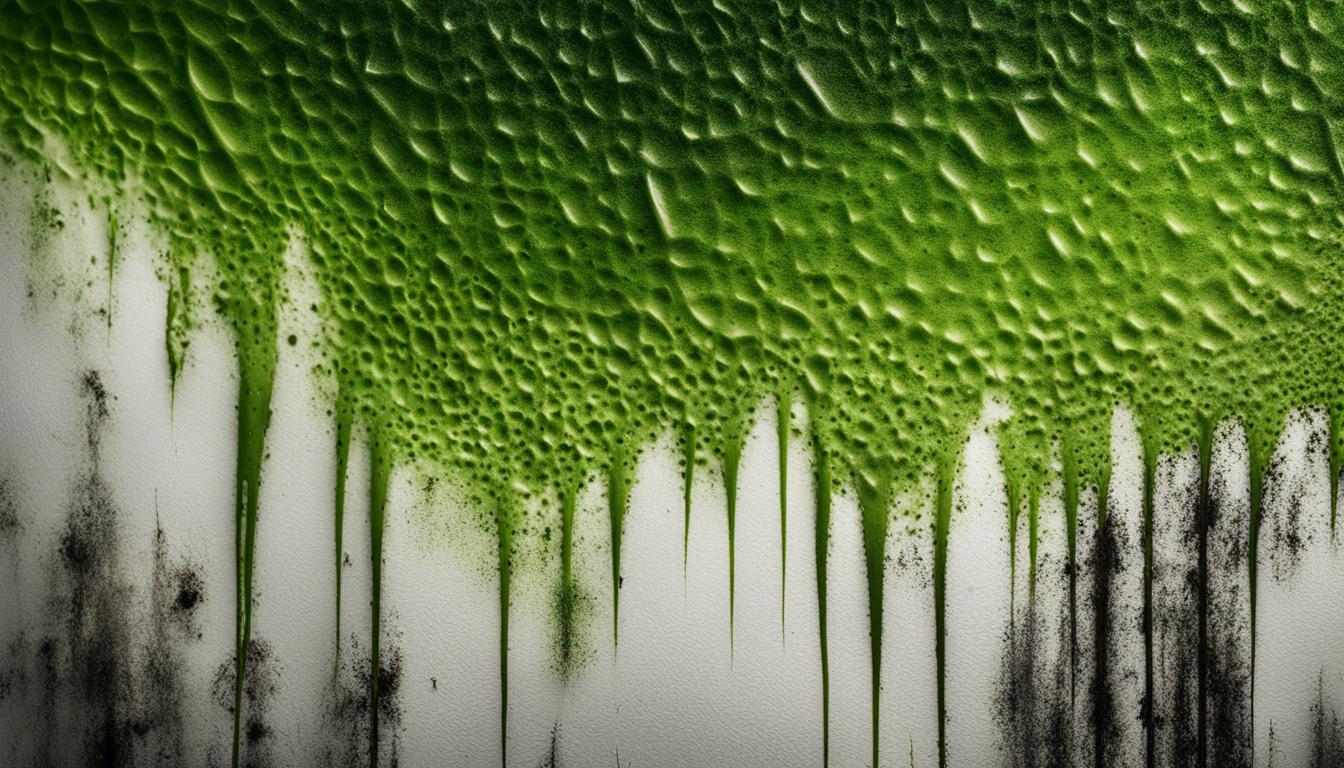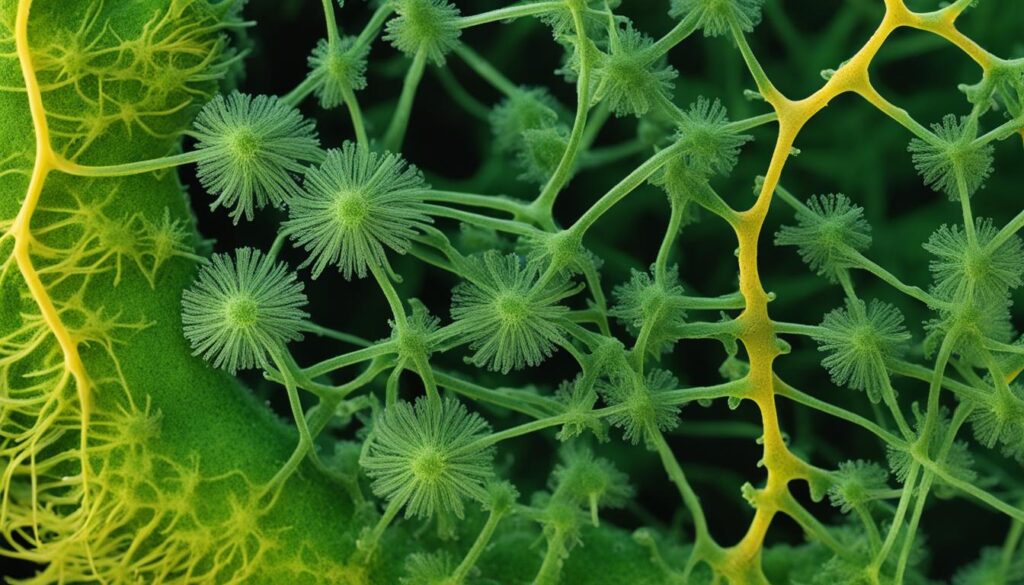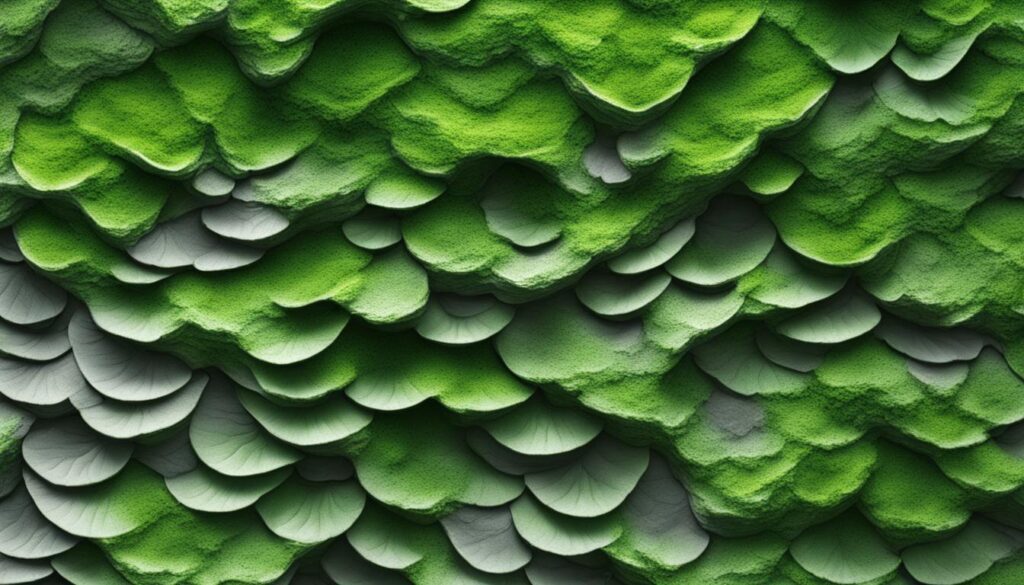
Common Household Mold Types Explained
Mold is an unsightly and potentially dangerous problem that can crop up in any home. Different types of mold can cause a range of health issues, from allergies to respiratory illness. It’s important to be able to recognize and address household mold, which is why we’ve put together this article to explain the most common types of household mold.
Key Takeaways:
- Household mold can cause health issues
- It’s important to be able to recognize different types of mold
- There are several common types of household mold
- Some types of mold can be more dangerous than others
- Addressing household mold promptly can prevent further health concerns
Understanding Cladosporium Mold
Cladosporium mold is one of the most common household mold varieties.
It is known for its olive-green to brown appearance and can be found in damp areas such as bathrooms and kitchens.
When the growth of Cladosporium mold exceeds normal levels, it can cause health problems. This includes symptoms such as coughing, wheezing, and respiratory tract infections.
To prevent the growth of Cladosporium mold, it is important to keep indoor spaces clean and dry, especially in areas prone to dampness.
Regular cleaning of surfaces and proper ventilation can help to reduce the risk of mold growth.
Identifying Alternaria Mold
Alternaria mold is a common type of mold found in households. It can grow in damp places, such as bathrooms and kitchens, but can also thrive in cooler areas like basements and garages. This mold can be recognized by its velvet-like texture, green or gray color, and its distinctive “woolly” appearance.
The most common symptoms of Alternaria exposure are similar to allergy symptoms, such as sneezing, coughing, and runny nose. In some cases, it can also cause asthma attacks and other respiratory problems. If you suspect Alternaria mold in your home, it is essential to take immediate action to prevent further growth and exposure.
Here’s how to identify Alternaria mold:
| Appearance | Where it grows | How to recognize it |
|---|---|---|
| Velvet-like texture, green or gray color | Damp places, such as bathrooms and kitchens, cooler areas like basements and garages | Distinctive “woolly” appearance |
As with any mold problem, it is crucial to identify and eliminate the source of excess moisture that allows mold to grow in the first place. Regularly clean and dry damp areas to prevent mold growth and take quick action to address any leaks or water damage.
All About Aspergillus Mold
Aspergillus is a common type of mold found in many residential homes. This mold can grow on various surfaces, including food, paper, and insulation, particularly in poorly ventilated areas such as basements and bathrooms. Aspergillus can also thrive in humid environments, making it prevalent in states with high levels of moisture in the air.
There are over 185 known species of Aspergillus, and six of them are known to cause health problems in humans. Exposure to Aspergillus can result in respiratory infections, such as asthma and bronchitis, especially for people with weakened immune systems.

The most prevalent species of Aspergillus include Aspergillus flavus, Aspergillus fumigatus, and Aspergillus niger. Inhaling Aspergillus spores can also lead to allergic reactions, such as sneezing, runny nose, and watery eyes.
It is crucial to detect and address Aspergillus mold growth before it becomes a serious health issue. The best way to prevent Aspergillus growth is to maintain a clean and dry living environment and proper ventilation in moisture-prone areas of the home.
Exploring Penicillium Mold
Penicillium mold is a common type of household mold found in damp and poorly ventilated areas. It typically appears blue or green and has a velvety texture. Penicillium can be found in different types of mold in households, including carpets, wallpaper, and insulation materials.
One of the most common health concerns related to Penicillium is its ability to trigger allergic reactions, such as asthma, hay fever, and respiratory issues, in susceptible individuals. It can also cause hypersensitivity pneumonitis in rare cases.
Preventing the growth of Penicillium requires keeping your living space dry and well-ventilated. In case of an infestation, it is essential to address the underlying moisture problems and remove any contaminated materials. Professional mold removal services may be necessary for larger outbreaks.
The Dangers of Stachybotrys Mold
Stachybotrys mold, commonly referred to as black mold, is one of the most dangerous types of mold found in residential areas. It thrives in warm, damp environments and is often found in areas with water damage, such as leaky roofs, pipes, or windows.
Exposure to Stachybotrys mold can have severe health consequences, such as respiratory issues, allergies, and in extreme cases, neurological symptoms. This type of mold produces mycotoxins that can be harmful when inhaled.
| Signs of Stachybotrys Mold | How to Address Stachybotrys Mold |
|---|---|
| • Black, slimy appearance • Musty odor • Allergic reactions • Respiratory issues |
• Identify the source of moisture and fix it • Remove affected materials • Wear protective gear when cleaning • Consult a professional mold remediation service |
To prevent Stachybotrys mold growth, it is essential to address any water damage immediately and maintain proper ventilation, especially in areas prone to dampness, such as bathrooms and kitchens. Regularly inspecting the home for any water damage can also help catch the problem early.
Do not underestimate the dangers of Stachybotrys mold. Recognizing its signs and taking appropriate action can ensure a healthy and safe living environment for you and your family.
Mold Types: Clinging to Acremonium
Among the different mold types in homes, Acremonium can often be found in humid environments, such as air conditioning systems and drain pans. It typically appears as a powdery substance and can potentially cause health problems, particularly for those with weakened immune systems.
Acremonium molds are slow-growing but can spread quickly once established, producing mycotoxins that may cause respiratory problems. Prolonged exposure can result in serious health issues, including liver disease and cancer. Therefore, it’s essential to take adequate measures to prevent the spread of this type of household mold.

Efforts to control Acremonium mold typically involve remediation to eliminate any sources of moisture and providing adequate ventilation. This should be done with the help of professionals to ensure proper containment and removal of contaminated materials and to prevent the spread of spores that may trigger allergic reactions.
Uncovering the Hazards of Chaetomium Mold
Chaetomium mold is a type of mold commonly found in residential areas. It typically thrives in areas with high moisture levels, such as bathrooms, kitchens, and basements. This mold appears cotton-like in texture and changes colors as it matures, initially starting from white or grey and ending up dark brown or black.
Like other types of mold, Chaetomium can have significant health effects on people. Prolonged exposure can lead to respiratory problems and weakened immune systems. This should not be taken lightly and requires immediate inspection and removal when found.
Common Locations of Chaetomium Mold in Houses
| Location | Description |
|---|---|
| Bathroom | As it thrives in moist environments, Chaetomium can develop on bathroom tiles, curtains, and in the shower or bath, especially bath mats or loofah |
| Kitchen | It can develop in the kitchen, especially underneath or on top of the sink, countertops, and other areas that collect moisture. |
| Basement | Since basements are susceptible to dampness, mold can develop on the walls, floor, and ceilings. It is not uncommon to find Chaetomium in this area |
| Living Room | It can develop on furniture, curtains, and the carpet if there is an excess amount of moisture present |
| Bedroom | If the bedroom is not adequately ventilated, it can develop on wardrobes, curtains, and pillows. This can cause sleep discomfort and other serious health effects. |
To prevent Chaetomium growth, it is essential to explore possible measures that will help control moisture levels in your house. Addressing water damage, ensuring proper ventilation, and keeping humidity levels in check is necessary.
Dealing with Fusarium Mold
Fusarium is a common household mold that can be found in damp areas such as basements, bathrooms and kitchens. It is a rapidly growing mold that can quickly spread through a home if not dealt with properly. Fusarium mold can appear pink, red, white, or gray, and can give off a musty or earthy smell.
It thrives in high humidity environments and can often be found in stored grains, soil, and plants. Exposure to Fusarium mold can lead to respiratory problems, eye irritation, and skin rashes.
The best way to deal with Fusarium mold is by preventing it from growing in the first place. This can be achieved by keeping the humidity level in the home below 60%, fixing any leaks or water damage promptly, and ensuring proper ventilation in areas prone to moisture.
If Fusarium mold is already present, it should be removed as soon as possible. This can be done by wearing protective gear, such as gloves and a mask, and using a solution of bleach and water to clean affected areas. Professional mold remediation services may also be necessary in severe cases.
Conclusion
In conclusion, it is essential to understand the common household mold types that may exist in homes. Mold types in homes can pose serious health risks, and identifying and addressing them is crucial for a safe and healthy living environment. We have explored the characteristics, favored environments, and potential health implications of Cladosporium, Alternaria, Aspergillus, Penicillium, Stachybotrys, Acremonium, Chaetomium, and Fusarium mold types in houses. By being aware of these household mold types, homeowners can take the necessary steps to prevent their growth and mitigate any existing mold infestations.
Regular maintenance and inspections can help detect mold growth early on, and a professional mold remediation service should be contacted for extensive mold damage. Remember, prevention is key when it comes to common household mold. Stay vigilant and maintain a clean and dry living environment to avoid mold types in homes. By taking these preventive measures, you can ensure that your home remains free from common household mold and the potential health hazards that they may cause.
FAQ
What are the common types of household mold?
The common types of household mold include Cladosporium, Alternaria, Aspergillus, Penicillium, Stachybotrys (black mold), Acremonium, Chaetomium, and Fusarium.
What is Cladosporium mold?
Cladosporium is a common type of mold found in households. It typically appears as black or greenish patches and is commonly found in areas with high moisture levels like bathrooms, kitchens, and basements. Exposure to Cladosporium mold can cause allergic reactions and respiratory issues.
What is Alternaria mold?
Alternaria mold is another common type found in houses. It has a velvety texture and can appear in various colors like green, brown, or black. It tends to grow in damp areas such as showers, sinks, and window sills. Exposure to Alternaria mold can cause allergic reactions and respiratory problems.
What is Aspergillus mold?
Aspergillus is a widespread mold that comes in different forms and colors. It can be found in damp and humid areas like basements, bathrooms, and air conditioning systems. Some species of Aspergillus mold can produce toxins that may cause respiratory issues and allergic reactions.
What is Penicillium mold?
Penicillium mold is commonly found in households and can have a blue or greenish appearance. It thrives in damp areas, such as bathrooms and water-damaged buildings. Penicillium mold can also be found on food items and may cause allergic reactions and respiratory problems.
What is Stachybotrys mold?
Stachybotrys mold, commonly referred to as black mold, is a dark-greenish or black mold species that thrives in damp and water-damaged areas. It is known for its toxic properties and can cause severe health issues, including respiratory problems, allergies, and even neurological symptoms.
What is Acremonium mold?
Acremonium mold typically appears as a powdery substance with colors ranging from pink to gray. It is commonly found in damp places like humidifiers, drain pans, and window sealants. Exposure to Acremonium mold can lead to various health problems, including respiratory issues and immune system suppression.
What is Chaetomium mold?
Chaetomium mold is often found in water-damaged areas, such as basements, attics, and bathrooms. It has a cotton-like texture and can change colors as it matures, starting with white and progressing to gray or black. Exposure to Chaetomium mold can cause allergic reactions and respiratory problems.
What is Fusarium mold?
Fusarium mold is commonly found in humid conditions and can appear as a pink or reddish mold with a cottony texture. It can be found in areas of water damage, such as plumbing leaks or flooding. Fusarium mold exposure can cause allergic reactions, respiratory issues, and eye infections.




